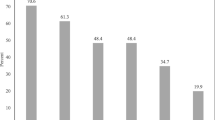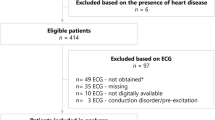Abstract
Mad honey intoxication (MHI) is a food-induced clinical condition that usually presents with cardiovascular symptoms and can lead to life-threatening arrhythmias if not diagnosed and treated early. No data exist in the literature on the presence of interatrial block (IAB) after food intoxication. In our study, we sought to investigate atrioventricular electrocardiography (ECG) parameters and determine the frequency of IAB in patients with MHI. In total, 76 patients diagnosed with MHI were included in our retrospective study. Twelve-lead ECGs were performed and participants were divided into two groups according to the presence of IAB in the reference ECG. The P maximum (Pmax), P minimum (Pmin), P dispersion (Pdisp), T peak to T end (Tp–Te) interval and QT dispersion (QTdisp) values were compared between the two groups. IAB was detected in 28 (35.5%) of 76 MHI patients included in the final analysis. Pmax duration (122 ± 8; p < 0.001) and PD (69 ± 11; p < 0.001) were significantly higher in the IAB ( +) group. During regression analysis, Pmax [odds ratio (OR) 1.158, 95% confidence interval (CI) 1.036–1.294; p = 0.010] and Pd (OR 1.086, 95% CI 1.001–1.017; p = 0.046) were independently associated with IAB. Pmax and Pd area under the receiver operating characteristic curve values for IAB prediction were 0.926 (95% CI 0.841–1,000; p < 0.001) and 0.872 (95% CI 0.765–0.974; p < 0.001), respectively. ECG changes are common in patients presenting with MHI. These patients need to be followed up clinically in terms of progression to arrhythmic events that may occur in the future.



Similar content being viewed by others
References
Yates, C., & Manini, A. F. (2012). Utility of the electrocardiogram in drug overdose and poisoning: Theoretical considerations and clinical implications. Current Cardiology Reviews, 8, 137–151.
Silici, S., & Atayoglu, A. T. (2015). Mad honey intoxication: A systematic review on the 1199 cases. Food and Chemical Toxicology, 86, 282–290.
Koca, I., & Koca, A. F. (2007). Poisoning by mad honey: A brief review. Food and Chemical Toxicology, 45, 1315–1318.
Gunduz, A., Turedi, S., Russell, R. M., & Ayaz, F. A. (2008). Clinical review of grayanotoxin/mad honey poisoning past and present. Clinical Toxicology, 46, 437–442.
Hodgson, E. (2012). Chapter fourteen—toxins and venoms. Progress in Molecular Biology and Translational Science, 112, 373–415.
Jansen, S. A., Kleerekooper, I., Hofman, Z. L., Kappen, I. F., Stary-Weinzinger, A., & van der Heyden, M. A. (2012). Grayanotoxin poisoning: ‘mad honey disease’ and beyond. Cardiovascular Toxicology, 12, 208–215.
Seyama, I., Yamaoka, K., Yakehiro, M., Yoshioka, Y., & Morihara, K. (1985). Is the site of action of grayanotoxin the sodium channel gating of squid axon? Japanese Journal of Physiology, 35, 401–410.
Erenler, A. K. (2016). Cardiac effects of mad honey poisoning and its management in emergency department: A review from Turkey. Cardiovascular Toxicology, 16, 1–4.
Kolecki, P. F., & Curry, S. C. (1997). Poisoning by sodium channel blocking agents. Critical Care Clinics, 13, 829–848.
Bayés de Luna, A., Baranchuk, A., Alberto Escobar Robledo, L., Massó van Roessel, A., & Martínez-Sellés, M. (2017). Diagnosis of interatrial block. Journal of Geriatric Cardiology, 14, 161–165.
Bayes de Luna, A. J. (1979). Bloqueo a nivel auricular [block at the auricular level]. Revista Espanola de Cardiologia, 32, 5–10.
Bazett, H. C. (1920). An analysis of the time-relations of electrocardiograms. Heart, 7, 353–370.
Salles, G. F., Cardoso, C. R., Leocadio, S. M., & Muxfeldt, E. S. (2008). Recent ventricular repolarization markers in resistant hypertension: Are they different from the traditional QT interval? American Journal of Hypertension, 21, 47–53.
Catterall, W. A., Cestèle, S., Yarov-Yarovoy, V., Yu, F. H., Konoki, K., & Scheuer, T. (2007). Voltage-gated ion channels and gating modifier toxins. Toxicon, 49, 124–141.
Maejima, H., Kinoshita, E., Seyama, I., & Yamaoka, K. (2003). Distinct sites regulating grayanotoxin binding and unbinding to D4S6 of Nav1.4 sodium channel as revealed by improved estimation of toxin sensitivity. Journal of Biological Chemistry, 278, 9464–9471.
Benoit, E. (1998). Mécanisme(s) d’action des neurotoxines agissant sur l’inactivation des canaux sodium activés par le potentiel de membrane [mechanism of action of neurotoxins acting on the inactivation of voltage-gated sodium channels]. Comptes Rendus des Seances de la Societe de Biologie et de Ses Filiales, 192, 409–436.
Seyama, I., Yamada, K., Kato, R., Masutani, T., & Hamada, M. (1988). Grayanotoxin opens Na channels from inside the squid axonal membrane. Biophysical Journal, 53, 271–274.
Yakehiro, M., Seyama, I., & Narahashi, T. (1997). Kinetics of grayanotoxin evoked modification of sodium channels in squid giant axons. Pflugers Archiv: European Journal of Physiology, 433, 403–412.
Yuki, T., Yamaoka, K., Yakehiro, M., & Seyama, I. (2001). State-dependent action of grayanotoxin I on Na(+) channels in frog ventricular myocytes. Journal of Physiology, 534, 777–790.
Yakehiro, M., Yuki, T., Yamaoka, K., Furue, T., Mori, Y., Imoto, K., & Seyama, I. (2000). An analysis of the variations in potency of grayanotoxin analogs in modifying frog sodium channels of differing subtypes. Molecular Pharmacology, 58, 692–700.
Aygun, A., Sahin, A., Karaca, Y., Turkmen, S., Turedi, S., Ahn, S. Y., Kim, S., & Gunduz, A. (2017). Grayanotoxin levels in blood, urine and honey and their association with clinical status in patients with mad honey intoxication. Turkish Journal of Emergency Medicine, 18, 29–33.
Choi, H. L., Park, K. H., Park, J. S., Choi, H. Y., Kim, H., & Kim, S. M. (2017). Relationship between blood toxin level and clinical features in patients with grayanotoxin poisoning—six clinical cases. Clinical Toxicology (Philadelphia, PA), 55, 991–995.
Othong, R., Devlin, J. J., & Kazzi, Z. N. (2015). Medical toxicologists’ practice patterns regarding drug-induced QT prolongation in overdose patients: A survey in the United States of America, Europe, and Asia Pacific region. Clinical Toxicology (Philadelphia, PA), 53, 204–209.
de Luna, A. B., Massó-van Roessel, A., & Robledo, L. A. E. (2015). The diagnosis and clinical implications of interatrial block. European Cardiology Review, 10, 54–59.
Bayés de Luna, A., Platonov, P., Cosio, F. G., Cygankiewicz, I., Pastore, C., Baranowski, R., Bayés-Genis, A., Guindo, J., Viñolas, X., Garcia-Niebla, J., Barbosa, R., Stern, S., & Spodick, D. (2012). Interatrial blocks. A separate entity from left atrial enlargement: A consensus report. Journal of Electrocardiology, 45, 445–451.
Istolahti, T., Eranti, A., Huhtala, H., Lyytikäinen, L. P., Kähönen, M., Lehtimäki, T., Eskola, M., Anttila, I., Jula, A., Bayés de Luna, A., & Nikus, K. (2020). The prevalence and prognostic significance of interatrial block in the general population. Annals of Medicine, 52, 63–73.
Alexander, B., Tse, G., Martinez-Selles, M., & Baranchuk, A. (2021). Atrial conduction disorders. Current Cardiology Reviews, 17, 68–73.
Onat, F., Yegen, B. C., Lawrence, R., Oktay, A., & Oktay, S. (1991). Site of action grayanotoxins in mad honey in rats. Journal of Applied Toxicology, 11, 199–291.
Yiğit, Z., Akdur, H., Ersanli, M., Ökçün, B., & Güven, Ö. (2003). The effect of exercise to P wave dispersion and its evaluation as a predictor of atrial fibrillation. Annals of Noninvasive Electrocardiology, 8, 308–312.
Dogan, U., Dogan, E. A., Tekinalp, M., Tokgoz, O. S., Aribas, A., Akilli, H., Ozdemir, K., Gok, H., & Yuruten, B. (2012). P-wave dispersion for predicting paroxysmal atrial fibrillation in acute ischemic stroke. International Journal of Medical Sciences, 9, 108–114.
Pérez-Riera, A. R., de Abreu, L. C., Barbosa-Barros, R., Grindler, J., Fernandes-Cardoso, A., & Baranchuk, A. (2016). P-wave dispersion: An update. Indian Pacing and Electrophysiology Journal, 16, 126–133.
Bayram, N. A., Keles, T., Durmaz, T., Dogan, S., & Bozkurt, E. (2012). A rare cause of atrial fibrillation: Mad honey intoxication. Journal of Emergency Medicine, 43, e389–e391.
Osken, A., Yaylacı, S., Aydın, E., Kocayigit, I., Cakar, M. A., Tamer, A., & Gündüz, H. (2012). Slow ventricular response atrial fibrillation related to mad honey poisoning. Journal of Cardiovascular Disease Research, 3, 245–247.
Kalkan, A., Gökçe, M., & Memetoğlu, M. E. (2012). An unusual clinical state: Atrial fibrillation due to mad-honey intoxication. Anatolian Journal of Cardiology, 12, 365–366.
Aliyev, F., Türkoglu, C., Celiker, C., Firatli, I., Alici, G., & Uzunhasan, I. (2009). Chronic mad honey intoxication syndrome: A new form of an old disease? Europace, 11, 954–956.
Funding
This research received no specific grant from any funding agency in the public, commercial, private, or not-for-profit sectors.
Author information
Authors and Affiliations
Contributions
All authors contributed to (1) substantial contributions to conception and design, or acquisition of data, or analysis and interpretation of data, (2) drafting the article or revising it critically for important intellectual content, and, (3) final approval of the version to be published.
Corresponding author
Ethics declarations
Conflict of interest
The Authors declare that there is no conflict of interest.
Ethics Approval
This study was approved by the Sakarya University ethics committee.
Additional information
Handling Editor: Vincent FM Segers.
Publisher's Note
Springer Nature remains neutral with regard to jurisdictional claims in published maps and institutional affiliations.
Rights and permissions
About this article
Cite this article
Ösken, A., Aydın, E., Özcan, K.S. et al. Evaluation of Electrocardiographic Parameters and the Presence of Interatrial Block in Patients with Mad Honey Intoxication. Cardiovasc Toxicol 21, 772–780 (2021). https://doi.org/10.1007/s12012-021-09668-9
Received:
Accepted:
Published:
Issue Date:
DOI: https://doi.org/10.1007/s12012-021-09668-9




